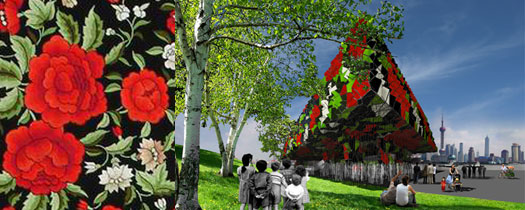
[No 5B. HABANERA IN HARMONY].
JULIAN
Where are you going in a Manila shawl?
Where are you going in a chiné dress?
SUSANA
To show myself off and see the verbena,
and later go off to my bed.
JULIAN
And why did you not come with me
after I pleaded with you so much?
SUSANA
Because I am going to pay at the chemist’s
for the things you made me suffer.
JULIÁN
And who is that most handsome lad
you’re going out with afterwards?
SUSANA
A person of dignity and
honour who is just how he should be.
JULIÁN
And what if it didn’t please me
for you to take his arm?
SUSANA
Then I’d go with him to the verbena
and to the bullfight at Carabanchel.
JULIÁN
That so? We’ll see about that right now.
(He throw himself at Hilarión to beat him,
the girls hold him back and shout.)
Manila Shawl, to show off and see the verbena.
Where are you going in a manila shawl? Well … The history of the Manila Shawl is the story of a one-way journey which now returns as the thread of a song. Where are you going in a chiné dress? Because …. the Manila Shawl is the story of a journey and is also the story of how cultures very distant in time and space are able to communicate with another and exchange characteristics. Manila Shawl displays a surprising link between the most immemorial of Chinese traditions and one of the most authentic Spanish garments. In the 16th century Spanish merchants in Manila were fascinated by the silk shawls brought by Chinese merchants and shipped them to Spain along the Philippines-Seville sea route via Acapulco. From that moment on these garments, originally Chinese, became known throughout the world as Spanish shawls or Manila shawls. The world is all mixed up and turned inside out, a perfect hybrid where flower motifs grow in size and adapt to the native flora with roses, irises, carnations, sunflowers … and lotus, so as not to lose the hint of the orient which gave, gives and will continue to give it an exotic touch which its success is based on. Because, after all, that Manila Shawl does want to go to the Shanghai Expo in 2010 to show itself off and see the verbena and perhaps not go off to its bed later.
Silk Fabric, construction and post-Expo strategy
The long voyage started with ancient technology which extracted threads from the cocoons made by silkworm larvae without damaging them. Here it has now become a process where a modular, prefabricated fabric is produced. The structured surface is based on hendecagons which form a grid over spaces. A series of equal-sized pieces made of thin metal bars make up the structural space of the building, walls, framing and supports. The hendecagons are webbed over with aluminium and glass panels on the outside, thus showing the structural fabric on the inside of the building. The result is a surface which on the outside imitates the sensual movement of a Manila Shawl draped over the shoulders of a gracefully dressed Sevillana woman, now crystallising in a texture which suddenly vibrates due to its way of reflecting light.
The building uses a prefabricated system with individual pieces being assembled on site. This enables thorough checks to be carried out and work to be completed very quickly while also allowing the building to be taken down without damage to its parts once the event has finished. In order to recycle the raw material used, there is a scheme to reuse the hendecagons in structures throughout Spain once the exhibition is finished, something which is possible thanks to the system’s versatility. They could end up part of a sculpture on a roundabout, a bus shelter, a tourist office, or a sports centre.
Shanghai Expo 2010. In operation.
The proposed building will be built on the Expo site and will provide a large amount of shade to protect the public area and the more public, more animated areas of the exhibition. Wide escalators will take the visitor up to the upper level, which houses a large, transverse atrium which overlooks the river. The atrium leads to three large areas. On one side are three exhibition halls – a fourth hall is situated on the ground floor to enable visitors to tour all four by walking around from the inside to the outside or the other way round. On another side are the smaller rooms for facilities such as offices, storerooms, toilets and changing rooms. The remaining side houses another escalator to access the top level, a large balcony overlooking the atrium which sometimes acts as a foyer for the function, press and multipurpose rooms. The function room can be merged with the press room to create a large open room surrounded by vibrant roof pillars.
